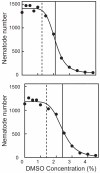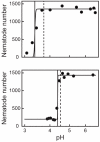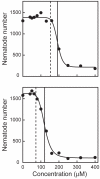A high-throughput method for assessing chemical toxicity using a Caenorhabditis elegans reproduction assay
- PMID: 20206647
- PMCID: PMC2871981
- DOI: 10.1016/j.taap.2010.02.014
A high-throughput method for assessing chemical toxicity using a Caenorhabditis elegans reproduction assay
Abstract
The National Research Council has outlined the need for non-mammalian toxicological models to test the potential health effects of a large number of chemicals while also reducing the use of traditional animal models. The nematode Caenorhabditis elegans is an attractive alternative model because of its well-characterized and evolutionarily conserved biology, low cost, and ability to be used in high-throughput screening. A high-throughput method is described for quantifying the reproductive capacity of C. elegans exposed to chemicals for 48 h from the last larval stage (L4) to adulthood using a COPAS Biosort. Initially, the effects of exposure conditions that could influence reproduction were defined. Concentrations of DMSO vehicle <or=1% did not affect reproduction. Previous studies indicated that C. elegans may be influenced by exposure to low pH conditions. At pHs greater than 4.5, C. elegans reproduction was not affected; however below this pH there was a significant decrease in the number of offspring. Cadmium chloride was chosen as a model toxicant to verify that automated measurements were comparable to those of traditional observational studies. EC(50) values for cadmium for automated measurements (176-192 microM) were comparable to those previously reported for a 72-h exposure using manual counting (151 microM). The toxicity of seven test toxicants on C. elegans reproduction was highly correlative with rodent lethality suggesting that this assay may be useful in predicting the potential toxicity of chemicals in other organisms.
(c) 2010 Elsevier Inc. All rights reserved.
Figures




Similar articles
-
High-Throughput Measurement for Toxic Effects of Metal Mixtures in Caenorhabditis elegans.Methods Mol Biol. 2021;2326:19-32. doi: 10.1007/978-1-0716-1514-0_2. Methods Mol Biol. 2021. PMID: 34097258
-
Medium- and high-throughput screening of neurotoxicants using C. elegans.Neurotoxicol Teratol. 2010 Jan-Feb;32(1):68-73. doi: 10.1016/j.ntt.2008.12.004. Epub 2009 Jan 6. Neurotoxicol Teratol. 2010. PMID: 19166924 Free PMC article.
-
High-throughput COPAS assay for screening of developmental and reproductive toxicity of nanoparticles using the nematode Caenorhabditis elegans.J Appl Toxicol. 2019 Oct;39(10):1470-1479. doi: 10.1002/jat.3833. Epub 2019 Jul 9. J Appl Toxicol. 2019. PMID: 31287177
-
Utility of Caenorhabditis elegans in high throughput neurotoxicological research.Neurotoxicol Teratol. 2010 Jan-Feb;32(1):62-7. doi: 10.1016/j.ntt.2008.11.005. Epub 2008 Dec 7. Neurotoxicol Teratol. 2010. PMID: 19087888 Review.
-
Caenorhabditis elegans, a Biological Model for Research in Toxicology.Rev Environ Contam Toxicol. 2016;237:1-35. doi: 10.1007/978-3-319-23573-8_1. Rev Environ Contam Toxicol. 2016. PMID: 26613986 Review.
Cited by
-
Seminar: Functional Exposomics and Mechanisms of Toxicity-Insights from Model Systems and NAMs.Environ Health Perspect. 2024 Sep;132(9):94201. doi: 10.1289/EHP13120. Epub 2024 Sep 4. Environ Health Perspect. 2024. PMID: 39230330 Free PMC article. Review.
-
Automated, high-throughput, motility analysis in Caenorhabditis elegans and parasitic nematodes: Applications in the search for new anthelmintics.Int J Parasitol Drugs Drug Resist. 2014 Oct 30;4(3):226-32. doi: 10.1016/j.ijpddr.2014.10.004. eCollection 2014 Dec. Int J Parasitol Drugs Drug Resist. 2014. PMID: 25516833 Free PMC article. Review.
-
Caenorhabditis elegans Model Studies Show MPP+ Is a Simple Member of a Large Group of Related Potent Dopaminergic Toxins.Chem Res Toxicol. 2021 May 17;34(5):1275-1285. doi: 10.1021/acs.chemrestox.0c00422. Epub 2021 Jan 26. Chem Res Toxicol. 2021. PMID: 33496570 Free PMC article.
-
Mitochondrial Morphology and Fundamental Parameters of the Mitochondrial Respiratory Chain Are Altered in Caenorhabditis elegans Strains Deficient in Mitochondrial Dynamics and Homeostasis Processes.PLoS One. 2015 Jun 24;10(6):e0130940. doi: 10.1371/journal.pone.0130940. eCollection 2015. PLoS One. 2015. PMID: 26106885 Free PMC article.
-
Metabolic profiling in Caenorhabditis elegans provides an unbiased approach to investigations of dosage dependent lead toxicity.Metabolomics. 2013 Feb;9(1):189-201. doi: 10.1007/s11306-012-0438-0. Epub 2012 Jun 4. Metabolomics. 2013. PMID: 23335868 Free PMC article.
References
-
- Aardema H, Meertens J, Ligtenberg JJM, Peters-Polman OM, Tulleken JE, Zijlstra JG. Organophosphorus pesticide poisoning: cases and developments. Neth. J. Med. 2008;66:149–153. - PubMed
-
- Anderson GL, Boyd WA, Williams PL. Assessment of sublethal endpoints for toxicity testing with the nematode Caenorhabditis elegans. Environ. Toxicol. Chem. 2001;20:833–838. - PubMed
-
- Anderson P. Mutagenesis. In: Epstein HF, Shakes DC, editors. Caenorhabditis elegans: Modern Biological Analysis of an Organism. Academic Press, Inc.; San Diego, CA: 1995. p. 58.
-
- Artal-Sanz M, de Jong L, Tavernarakis N. Caenorhabditis elegans: a versatile platform for drug discovery. Biotechnol. J. 2006;1:1405–1418. - PubMed
Publication types
MeSH terms
Grants and funding
LinkOut - more resources
Full Text Sources

